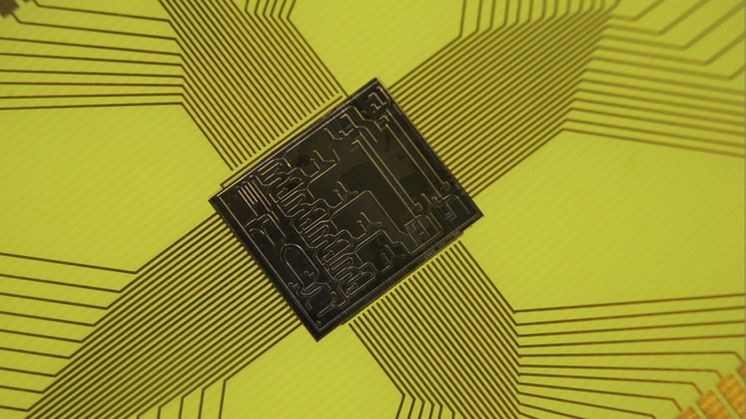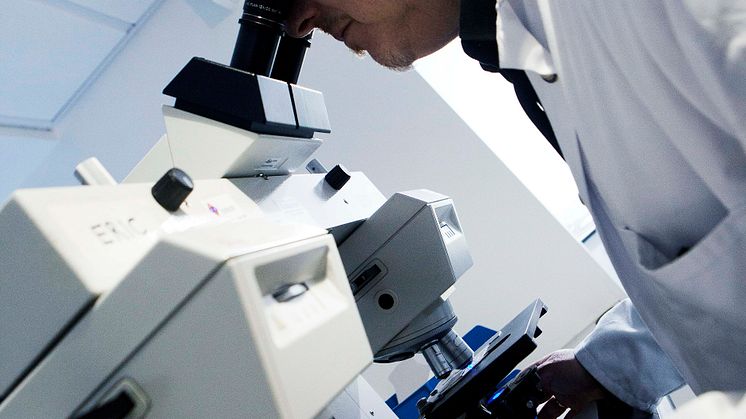
Press release -
COMMENT: How oversized atoms could help shrink "lab-on-a-chip" devices
Dr Rodrigo Ledesma Aguilar, discusses our ability to understand how fluids behave under extreme confinement
“Lab-on-a-chip” devices – which can carry out several laboratory functions on a single, micro-sized chip – are the result of a quiet scientific revolution over the past few years. For example, they enable doctors to make complex diagnoses instantly from a single drop of blood.
In the future, shrinking such devices to extremely small sizes, comparable to the liquid molecules themselves, will be a huge challenge; success will depend on our ability to understand how fluids behave under extreme confinement. In a recent study published in the journal Nature Communications, we came up with a new way of unveiling how fluids behave in such “superconfinement” using lumpy particles known as colloids to act as oversized atoms.
Milky rainbows
Atoms are tiny, tiny things. So small, you would not be able to see them under an optical microscope. But what if you could blow up the atoms in size? This is precisely what colloids do, they act as grossly oversized atoms. The technique can replicate many processes in liquids at atomic scales – something that is key for further developing lab-on-a-chip devices.
Colloids are all over the place, even in the milk you probably just poured in your tea. Milk is a water-based mixture, containing sugars, fats and proteins among other stuff. Many of these components aggregate into small lumps of about a thousand times smaller than a millimetre in size. Such lumps are what we call colloidal particles.

Would you like some colloidal solution with that? Laura D'Alessandro/Flickr, CC BY-SA
In fact, milk is a very good example of the power that colloids can have in science. By mixing milk and water in a tray and shining light through with a flashlight one canrecreate the effect behind the amazing colours you see in sunsets. In both cases, the sunset effect boils down to how light interacts with particles in a fluid.
In the atmosphere, light is scattered by the atoms and molecules, giving the sky its striking colours. However, the small size of the atoms means that you can only see the effect over relatively long distances of many kilometres. With milk, however, this effect is blown-up by the size of the colloidal particles, so you can see a glorious miniature sunset using just a torch and a tray!
Sunset in a jar – T Mantilla
But what exactly are colloids? Colloids are any kind of particles that are small and light enough not to settle immediately if you disperse them in a fluid – such as air or water – but not too small so that they dissolve in that fluid. Colloidal particles can range from 1 nanometre (that’s a millionth of a millimetre) to 1 micrometre in size (1,000th of a millimetre) and can be made of many different components.
Clever colloids
Back in the laboratory, we used a colloidal mix of spherical particles and polymer strands to understand how fluids behave in extremely small channels, such as a drop of water in a nano-fluidic chip device. The size of the particles in our mix is about 200 nanometres, so they fit nicely into our colloidal particle classification.
To give you an idea of how blown-up these atoms are, a water molecule, which is about 0.25 nanometres in diameter, is as a mere spec in front of the gigantic 200-nanometre colloid. The smart thing about this colloidal mix is that the polymer strands are able to squeeze between the spherical particles, sort of elbowing them out. This effect eventually results in the creation of a two-phase mixture, very similar to having oil separated from water. Crucially, the size of the colloidal “molecules” in our “liquids” is not too small compared to the size of a micro-channel, so we are able to use them as blown-up atoms to study a variety of phenomena in extreme confinement in micro-channels.

These microscopy images show a time sequence of jets and drops forming in superconfined colloidal fluids. Author provided
By changing the size of the channels, we were able to reveal in detail how a fluid interacts with the boundaries encasing it. We then used this understanding to control the formation of drops and jets only a few hundred times larger than the size of a colloidal particle. Crucially, the size of the colloidal particles made it possible to observe the fluid dynamics under such an extreme confinement in all its glory using nothing but direct optical techniques using confocal microscopy, – something that would have been impossible to do with a common liquid such as water.
So where to now?
The fluid structures that we have identified in the lab can be very useful in applications that go beyond our colloidal mixtures. For example, simple changes in the channel size can be used to create very small liquid droplets, which in turn can be used for lab-on-a-chip applications acting as drug carriers or miniature beakers for chemical reactions.
But the ability to control drops can also be potentially used to guide the self-assembly of specifically shaped particles, some sort of “colloidal bricks”, that could be used to produce more complex structures such as micro robots, which could for instance be used in large swarms to explore environments that are too small for larger robots. It could also help develop micro-based materials, such as high-grade micro-emulsions, which can be used, for example, cleaning products.
Such applications are not restricted to using our colloidal liquids, but are open to using many types of liquids, including water and oils, as long as they are contained in very small channels. Using knowledge from one system to understand another is not particular to colloids, it is an underpinning principle of how physics works to make sense of the world around us – and unveiling such generality is perhaps one of the most beautiful aspects of it.
![]()
Rodrigo Ledesma Aguilar is Senior Lecturer in Physics and Electrical Engineering at Northumbria University, Newcastle.
This article was originally published on The Conversation. Read the original article.
Categories
Northumbria is a research-rich, business-focussed, professional university with a global reputation for academic excellence. To find out more about our courses go towww.northumbria.ac.uk
If you have a media enquiry please contact our Media and Communications team at media.communications@northumbria.ac.uk or call 0191 227 4571.









